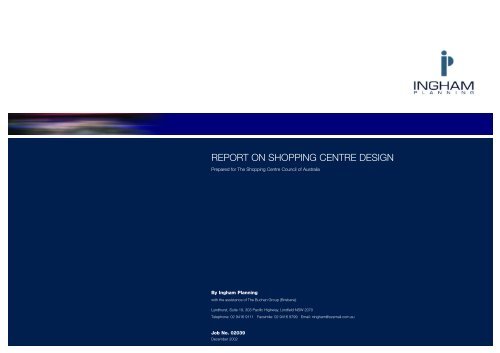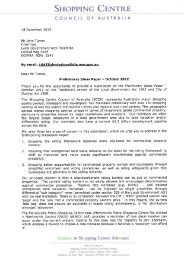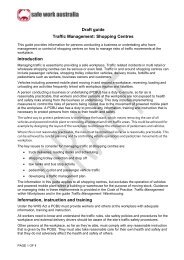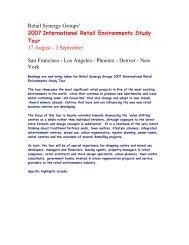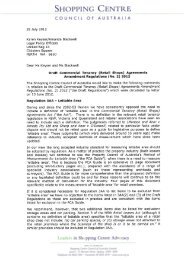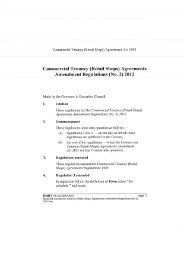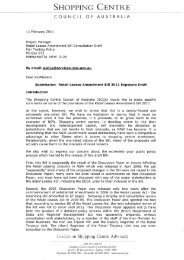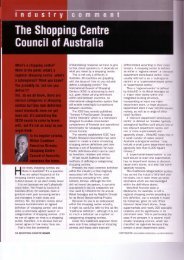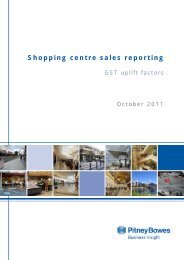report on shopping centre design - Shopping Centre Council of ...
report on shopping centre design - Shopping Centre Council of ...
report on shopping centre design - Shopping Centre Council of ...
You also want an ePaper? Increase the reach of your titles
YUMPU automatically turns print PDFs into web optimized ePapers that Google loves.
REPORT ON SHOPPING CENTRE DESIGN<br />
Prepared for The <strong>Shopping</strong> <strong>Centre</strong> <strong>Council</strong> <strong>of</strong> Australia<br />
By Ingham Planning<br />
with the assistance <strong>of</strong> The Buchan Group (Brisbane)<br />
Lyndhurst, Suite 19, 303 Pacific Highway, Lindfield NSW 2070<br />
Teleph<strong>on</strong>e: 02 9416 9111 Facsimile: 02 9416 9799 Email: ningham@ozemail.com.au<br />
Job No. 02039<br />
December 2002
INGHAM<br />
P L A N N I N G<br />
1<br />
1 Introducti<strong>on</strong><br />
This <str<strong>on</strong>g>report</str<strong>on</strong>g> is in resp<strong>on</strong>se to a brief from the <strong>Shopping</strong> <strong>Centre</strong> <strong>Council</strong> <strong>of</strong> Australia<br />
(SCCA) to provide an analysis <strong>of</strong> <strong>shopping</strong> <strong>centre</strong> <strong>design</strong> with particular regard to the<br />
Sydney metropolitan regi<strong>on</strong> and a discussi<strong>on</strong> <strong>of</strong> the major current issues in <strong>shopping</strong><br />
<strong>centre</strong> <strong>design</strong>. The brief follows a statement by Planning NSW's Urban Design<br />
Advisory Committee (UDAC) that it intends to investigate the creati<strong>on</strong> <strong>of</strong> <strong>design</strong><br />
guidelines for <strong>shopping</strong> <strong>centre</strong> development.<br />
The members <strong>of</strong> the SCCA are the owners/developers/managers <strong>of</strong> generally large<br />
<strong>shopping</strong> <strong>centre</strong>s. Therefore this <str<strong>on</strong>g>report</str<strong>on</strong>g> focuses <strong>on</strong> this form <strong>of</strong> retailing. The <str<strong>on</strong>g>report</str<strong>on</strong>g><br />
aims to assist UDAC in gaining an understanding <strong>of</strong> the industry perspective so that<br />
it is fully informed <strong>of</strong> the relevant issues in its c<strong>on</strong>siderati<strong>on</strong> <strong>of</strong> the possible guidelines.<br />
The <str<strong>on</strong>g>report</str<strong>on</strong>g> supplements the previous discussi<strong>on</strong>s held with the SCCA and its<br />
members and the presentati<strong>on</strong> by the SCCA to UDAC <strong>on</strong> 20 November 2002. As<br />
noted at this presentati<strong>on</strong> meeting, in additi<strong>on</strong> to providing this <str<strong>on</strong>g>report</str<strong>on</strong>g>, the SCCA,<br />
being the peak industry body, seeks a close working relati<strong>on</strong>ship with UDAC<br />
throughout the life <strong>of</strong> this project.<br />
The <strong>Shopping</strong> <strong>Centre</strong> <strong>Council</strong> <strong>of</strong> Australia<br />
The <strong>Shopping</strong> <strong>Centre</strong> <strong>Council</strong> <strong>of</strong> Australia (SCCA) is the nati<strong>on</strong>al retail property<br />
policy arm <strong>of</strong> the Property <strong>Council</strong> <strong>of</strong> Australia.<br />
SCCA represents owners and managers <strong>of</strong> <strong>shopping</strong> <strong>centre</strong>s in working for<br />
public policy outcomes which encourage the development <strong>of</strong> the <strong>shopping</strong><br />
<strong>centre</strong> industry.<br />
Primarily the SCCA represents owners <strong>of</strong> investment grade retail property. In the<br />
main these owners are superannuati<strong>on</strong> funds, listed property trusts and property<br />
syndicates entrusted with the prudent investment <strong>of</strong> the retirement savings <strong>of</strong><br />
milli<strong>on</strong>s <strong>of</strong> Australians.<br />
The SCCA members are:<br />
◗<br />
◗<br />
AMP Henders<strong>on</strong> Global Investors<br />
Centro Properties Group<br />
The <str<strong>on</strong>g>report</str<strong>on</strong>g> includes the following Secti<strong>on</strong>s:<br />
Secti<strong>on</strong> 2 provides a discussi<strong>on</strong> <strong>of</strong> the evoluti<strong>on</strong> <strong>of</strong> <strong>shopping</strong> <strong>centre</strong> <strong>design</strong> and<br />
identificati<strong>on</strong> <strong>of</strong> the recent and current trends;<br />
Secti<strong>on</strong> 3 summarises the current planning framework for the c<strong>on</strong>siderati<strong>on</strong> <strong>of</strong><br />
<strong>shopping</strong> <strong>centre</strong> proposals;<br />
◗<br />
◗<br />
◗<br />
◗<br />
◗<br />
CFS Gandel Retail Trust<br />
Deutsche Asset Management (Australia)<br />
FPD Savills/Byvan<br />
Intro Internati<strong>on</strong>al<br />
J<strong>on</strong>es Lang LaSalle<br />
Secti<strong>on</strong> 4<br />
discusses the main <strong>design</strong> issues for <strong>shopping</strong> <strong>centre</strong>s and includes<br />
comments about the <strong>design</strong> process and the key functi<strong>on</strong>al aspects<br />
which influence <strong>design</strong>;<br />
◗<br />
◗<br />
Leda Holdings<br />
Lend Lease Retail<br />
Secti<strong>on</strong> 5<br />
provides a summary <strong>of</strong> c<strong>on</strong>clusi<strong>on</strong>s drawn from the preceding<br />
secti<strong>on</strong>s.<br />
◗<br />
◗<br />
Macquarie CountryWide Trust<br />
McC<strong>on</strong>aghy Holdings<br />
Throughout the <str<strong>on</strong>g>report</str<strong>on</strong>g> are examples <strong>of</strong> recent <strong>shopping</strong> <strong>centre</strong> development which<br />
highlight the high quality <strong>of</strong> current <strong>design</strong>.<br />
◗<br />
◗<br />
◗<br />
◗<br />
◗<br />
◗<br />
MCS Property Limited<br />
Perr<strong>on</strong> Group<br />
Queensland Investment Corporati<strong>on</strong><br />
Stockland Trust Group<br />
Westfield Holdings Limited<br />
Yu Feng Group.
INGHAM<br />
P L A N N I N G<br />
2<br />
2 Changing Directi<strong>on</strong>s<br />
<strong>Shopping</strong> <strong>centre</strong>s <strong>of</strong> the type described began being established in Australia in the<br />
late 1950's. In the beginning, these <strong>shopping</strong> <strong>centre</strong>s were a tool to fill the gap<br />
created by a need for the c<strong>on</strong>venient and efficient distributi<strong>on</strong> <strong>of</strong> goods to a fast<br />
growing populati<strong>on</strong>.<br />
During the late 60's and 70's the <strong>design</strong> <strong>of</strong> <strong>shopping</strong> <strong>centre</strong>s resulted in some very<br />
basic, pragmatic layouts and <strong>of</strong>ten unimaginative exterior presentati<strong>on</strong>. Features <strong>of</strong><br />
these <strong>centre</strong>s included:<br />
Then the 90's came al<strong>on</strong>g with the growing world movement <strong>of</strong> new urbanism and<br />
smart growth, a search for authenticity, and an even greater focus <strong>on</strong> entertainment<br />
and eating. Planning authorities have encouraged the establishment and<br />
revitalisati<strong>on</strong> <strong>of</strong> town <strong>centre</strong>s. The market is now also demanding an envir<strong>on</strong>ment<br />
where the basic aspects <strong>of</strong> daily life can be accommodated in a way that is<br />
c<strong>on</strong>venient and enjoyable. The establishment <strong>of</strong> mixed use areas where people can<br />
work, rest and play have become the focus <strong>of</strong> both new areas and urban renewal<br />
projects. The <strong>shopping</strong> <strong>centre</strong> plays an integral part in this process and in some<br />
cases provides the basis for the creati<strong>on</strong> <strong>of</strong> new and revitalised town <strong>centre</strong>s.<br />
◗<br />
◗<br />
◗<br />
◗<br />
◗<br />
Large carparks<br />
No links to the local community<br />
Large box shapes<br />
Often poor regard for the surrounding envir<strong>on</strong>ment<br />
The capture and c<strong>on</strong>tain mentality.<br />
As the 70's progressed we find a few <strong>centre</strong>s starting to questi<strong>on</strong> the <strong>design</strong> and<br />
layout that had become regarded as typical. The first <strong>centre</strong> to do this was Pacific<br />
Fair <strong>on</strong> the Gold Coast in Queensland. This <strong>centre</strong> followed the open air approach<br />
and looked to establish a fabric <strong>of</strong> streets, places and parks. The large box <strong>design</strong><br />
was modulated by laminating other smaller active buildings <strong>on</strong>to the edge <strong>of</strong> these<br />
boxes.<br />
After this we find the approach to <strong>shopping</strong> <strong>centre</strong> <strong>design</strong> changed rapidly with<br />
greater amounts <strong>of</strong> style being created. A lot <strong>of</strong> this change was caused by the fact<br />
that most <strong>of</strong> the catch up to demand had been fulfilled in the 60's and early 70's<br />
and hence to achieve a successful <strong>shopping</strong> <strong>centre</strong> <strong>on</strong>e had to compete with<br />
various other retail opportunities.<br />
However <strong>on</strong>e could see that the customer was beginning to demand better<br />
<strong>design</strong>ed envir<strong>on</strong>ments to shop in and <strong>of</strong> course recreate in. Recreati<strong>on</strong> time had<br />
been recognised as a commodity and hence the retail sector started to provide<br />
recreati<strong>on</strong>al opportunities such as:<br />
◗<br />
◗<br />
◗<br />
◗<br />
Cinemas<br />
Cafes<br />
Lifestyle retail<br />
Entertainment in various forms.<br />
Harbour Town in Queensland (Fig 1, top) and Knox City in Victoria (Fig 2, above) highlight the change in directi<strong>on</strong> <strong>of</strong><br />
<strong>shopping</strong> <strong>centre</strong> <strong>design</strong> - far removed from the traditi<strong>on</strong>al c<strong>on</strong>crete box.
INGHAM<br />
P L A N N I N G<br />
3<br />
What does the future hold The following list highlights some recent trends:<br />
3 The Current Planning Framework<br />
◗<br />
◗<br />
◗<br />
◗<br />
◗<br />
◗<br />
◗<br />
◗<br />
◗<br />
increasing spending <strong>on</strong> food and merchandise;<br />
greater diversity <strong>of</strong> uses in <strong>shopping</strong> <strong>centre</strong>s, particularly the provisi<strong>on</strong> <strong>of</strong><br />
entertainment/lifestyle attracti<strong>on</strong>s such as cinemas;<br />
creati<strong>on</strong> <strong>of</strong> precincts targeted towards certain parts <strong>of</strong> the market;<br />
the impact <strong>of</strong> the increasing popularity <strong>of</strong> electr<strong>on</strong>ic services such as internet<br />
<strong>shopping</strong> and ph<strong>on</strong>e banking;<br />
creating envir<strong>on</strong>ments that resp<strong>on</strong>d to changing demographics including more<br />
singles and childless couples and increasing average age;<br />
creating envir<strong>on</strong>ments where people feel comfortable including the identificati<strong>on</strong><br />
<strong>of</strong> the 'third place' - a place away from home and work where people want to<br />
spend their time;<br />
recreating the 'high street' or 'old town <strong>centre</strong>' <strong>shopping</strong> experience including<br />
externalisati<strong>on</strong> <strong>of</strong> spaces, better integrati<strong>on</strong> into surrounding c<strong>on</strong>text and<br />
permeability;<br />
the breaking down <strong>of</strong> visits into categories including chore <strong>shopping</strong>,<br />
discreti<strong>on</strong>ary <strong>shopping</strong> and leisure activities such as eating, drinking and<br />
moviegoing;<br />
the importance <strong>of</strong> <strong>design</strong> aesthetics including the use <strong>of</strong> high pr<strong>of</strong>ile<br />
architects/interior <strong>design</strong>ers.<br />
As noted above, there has been a significant shift in the retail sector and customers<br />
are far more discerning <strong>of</strong> the envir<strong>on</strong>ment in which they shop. The market itself is<br />
generating a demand for more integrated, multi-use and well <strong>design</strong>ed <strong>centre</strong>s.<br />
It is not <strong>on</strong>ly customers that are driving the need for better <strong>design</strong>, the expectati<strong>on</strong>s<br />
<strong>of</strong> the relevant planning authorities have also increased. These days, <strong>shopping</strong><br />
<strong>centre</strong> <strong>design</strong>ers know that their proposals will be subject to intensive scrutiny by a<br />
vast range <strong>of</strong> pr<strong>of</strong>essi<strong>on</strong>als, politicians and the public. One <strong>on</strong>ly has to look at the<br />
current standard <strong>of</strong> <strong>design</strong>, as can be seen throughout this <str<strong>on</strong>g>report</str<strong>on</strong>g>, to know that<br />
developers now take the issue <strong>of</strong> <strong>design</strong> very seriously. In keeping with changing<br />
expectati<strong>on</strong>s, planning authorities have been taking greater interest in <strong>shopping</strong><br />
<strong>centre</strong>s and urban <strong>design</strong> generally. The following discussi<strong>on</strong> provides details <strong>of</strong> the<br />
current planning framework within which <strong>shopping</strong> <strong>centre</strong>s (in Sydney) are assessed.<br />
This range <strong>of</strong> influences highlights that urban <strong>design</strong> is but <strong>on</strong>e <strong>of</strong> many factors that<br />
need to be c<strong>on</strong>sidered. A well <strong>design</strong>ed <strong>shopping</strong> <strong>centre</strong> does not necessarily result<br />
in a successful <strong>shopping</strong> <strong>centre</strong>. C<strong>on</strong>versely, there are <strong>centre</strong>s which many would<br />
say are unattractive, yet they are very successful. A balanced approach will c<strong>on</strong>sider<br />
all <strong>of</strong> the above matters in order to achieve a positive outcome for all.<br />
Activati<strong>on</strong> <strong>of</strong> streets and public spaces has been <strong>on</strong> the planning agenda for a number <strong>of</strong> years. Westfield Burwood<br />
(Fig 4, left) and Castle Towers (Fig 5, right) provide examples <strong>of</strong> how recent development is successfully resp<strong>on</strong>ding<br />
to this issue.<br />
3.1 State planning<br />
For many years, strategy plans for the Sydney metropolitan regi<strong>on</strong> have sought to<br />
encourage the c<strong>on</strong>centrati<strong>on</strong> <strong>of</strong> employment and commerce in major urban <strong>centre</strong>s.<br />
This policy c<strong>on</strong>tinues in the latest metropolitan strategy "Shaping Our Cities". There<br />
are no State government planning policies which specifically relate to the<br />
development <strong>of</strong> <strong>shopping</strong> <strong>centre</strong>s. Without any adequate statutory planning<br />
instruments in place, there have been a c<strong>on</strong>siderable number <strong>of</strong> significant retail<br />
outlets approved in 'out-<strong>of</strong> <strong>centre</strong>' locati<strong>on</strong>s.<br />
Castle Towers in NSW (Fig 3) evokes the 'old town <strong>centre</strong>' <strong>shopping</strong> experience.<br />
However, draft State Envir<strong>on</strong>mental Planning Policy No 66 - Integrating Land Use<br />
and Transport has been exhibited and has aims which include discouraging the<br />
establishment <strong>of</strong> significant employment or people generating activities in out-<strong>of</strong>
INGHAM<br />
P L A N N I N G<br />
4<br />
<strong>centre</strong> locati<strong>on</strong>s. This includes <strong>shopping</strong> <strong>centre</strong>s. The draft SEPP also c<strong>on</strong>tains<br />
provisi<strong>on</strong>s that relate specifically to <strong>shopping</strong> <strong>centre</strong> <strong>design</strong>. In this regard, part <strong>of</strong><br />
the Planning Policy Package <strong>of</strong> which draft SEPP 66 is a part includes the following<br />
relevant documents:<br />
'The Right Place for Business and Services - Planning policy'. The explanatory<br />
notes <strong>of</strong> this policy include 'Part D. The right <strong>design</strong>'. The following issues are<br />
discussed:<br />
◗<br />
◗<br />
◗<br />
◗<br />
◗<br />
<strong>design</strong> pointers for <strong>centre</strong>s;<br />
<strong>design</strong> guidelines;<br />
public realm;<br />
safety and security; and<br />
transport choice and integrati<strong>on</strong>.<br />
'Improving Transport Choice - Guidelines for planning and development'. Part 1<br />
c<strong>on</strong>tains the 'Accessible Development Principles'. Principle 2 relates to 'Mixed Uses<br />
in <strong>Centre</strong>s'. The following <strong>design</strong> related matters are noted as being 'best practice':<br />
◗ a feeling <strong>of</strong> security is assisted by buildings and active uses, such as cafes and<br />
fr<strong>on</strong>t verandahs, being oriented to the street.<br />
Principle 7 relates to improving cycle access and c<strong>on</strong>tains the following relevant<br />
point:<br />
◗ bicycle storage is c<strong>on</strong>veniently located close to building entries and at ground<br />
level.<br />
Principle 8 relates to managing parking supply and c<strong>on</strong>tains the following relevant<br />
points:<br />
◗ in activity <strong>centre</strong>s, parking is placed at the rear <strong>of</strong> buildings or internal to the<br />
block;<br />
◗ parking for people with disabilities is provided adjacent to key facilities - it must<br />
be enforced.<br />
Principle 10 relates to implementing good urban <strong>design</strong>. The following matters are<br />
noted as being 'best practice':<br />
◗ buildings and their pedestrian entrances are oriented to the street;<br />
◗<br />
◗<br />
◗<br />
◗<br />
◗<br />
◗<br />
key land uses are located within walking distance <strong>of</strong> each other (e.g. shops,<br />
library, childcare <strong>centre</strong>s, cinemas, bus/rail interchange);<br />
the highest densities <strong>of</strong> housing and employment appropriate to an area, are<br />
located within walking distance <strong>of</strong> public transport nodes;<br />
uses are mixed either vertically within the same building, or horiz<strong>on</strong>tally <strong>on</strong><br />
adjacent sites;<br />
functi<strong>on</strong>al requirements, such as servicing, and impacts such as sound, odours<br />
and identity in the layout and <strong>design</strong> <strong>of</strong> horiz<strong>on</strong>tally and vertically mixed uses, are<br />
c<strong>on</strong>sidered;<br />
pedestrian and bicycle access is safe, direct and comfortable between uses;<br />
plans and codes encourage home businesses and home workplaces.<br />
Principle 6 relates to improving pedestrian access and c<strong>on</strong>tains the following<br />
relevant points:<br />
◗<br />
every development has c<strong>on</strong>venient and prominent pedestrian entrances, in<br />
terms <strong>of</strong> <strong>design</strong>, signage, lighting and gradient;<br />
◗<br />
◗<br />
◗<br />
◗<br />
◗<br />
◗<br />
building setbacks are minimised to provide natural surveillance <strong>of</strong> footpaths, bus<br />
stops and taxi ranks, while still allowing sunlight access and minimising wind<br />
tunnel effects;<br />
attractive streetscapes reinforce the functi<strong>on</strong>s <strong>of</strong> the street and enhance the<br />
amenity <strong>of</strong> adjacent development;<br />
bus stops are located and <strong>design</strong>ed to provide shelter, seats, adequate lighting,<br />
and timetable informati<strong>on</strong>; they provide access for people with disabilities, and<br />
are overlooked from nearby buildings;<br />
footpaths, cycleways and taxi ranks are well-lit and located where there is<br />
natural surveillance from adjacent uses;<br />
pedestrian amenity is enhanced by attractive, coordinated street furniture,<br />
lighting and signage;<br />
the <strong>design</strong> <strong>of</strong> development in accessible <strong>centre</strong>s, especially involving railway<br />
stati<strong>on</strong>s, addresses issues <strong>of</strong> potential c<strong>on</strong>flicts, such as transport noise and<br />
vibrati<strong>on</strong>.<br />
◗<br />
expanses <strong>of</strong> ground level blank walls al<strong>on</strong>g street fr<strong>on</strong>tages, and large driveways<br />
and entrances to car parks are avoided;
INGHAM<br />
P L A N N I N G<br />
5<br />
◗<br />
◗<br />
◗<br />
◗<br />
As redevelopment occurs over time, retail complexes should be joined more<br />
directly with street fr<strong>on</strong>tages and bus stops;<br />
Clear signage should direct patr<strong>on</strong>s to public transport stops, taxi ranks and<br />
pedestrian links to adjacent uses. Public transport operators should provide<br />
timetable informati<strong>on</strong>, ranging from display cases to visual displays with<br />
touch/voice access;<br />
To encourage access by public transport, retail and other commercial and<br />
community facilities located in <strong>centre</strong>s with high frequency rail services should<br />
be developed with reduced or shared parking.<br />
These locati<strong>on</strong> and <strong>design</strong> guidelines can be equally applied to bulky goods<br />
outlets. The need for extensive same-level parking areas for loading bulky goods<br />
is <strong>of</strong>ten exaggerated and little different from other retail outlets.<br />
This secti<strong>on</strong> includes graphics which dem<strong>on</strong>strate how a traditi<strong>on</strong>al layout can be<br />
transformed over time (see Figure 7, below). Should draft SEPP 66 be gazetted, it<br />
will provide a comprehensive c<strong>on</strong>trol document for <strong>shopping</strong> <strong>centre</strong>s, not <strong>on</strong>ly<br />
dealing with locati<strong>on</strong>al and transport matters but also urban <strong>design</strong> issues.<br />
This recent upgrade <strong>of</strong> Macquarie <strong>Centre</strong> in NSW (Fig 6) shows how transport links (in this case a bus interchange)<br />
can be incorporated into <strong>shopping</strong> <strong>centre</strong> <strong>design</strong>.<br />
Part 3 <strong>of</strong> 'Improving Transport Choice' relates to locati<strong>on</strong> and <strong>design</strong> guidelines. In<br />
regard to retail development the following <strong>design</strong> guidelines are noted:<br />
◗<br />
◗<br />
Access by all transport modes should be encouraged. The c<strong>on</strong>figurati<strong>on</strong> <strong>of</strong><br />
shops and other services must seek a balance between pedestrian, cyclist and<br />
driver comfort, visibility and accessibility. <strong>Shopping</strong> <strong>centre</strong>s and malls,<br />
entertainment complexes and pers<strong>on</strong>al services <strong>of</strong>fices should be <strong>design</strong>ed to<br />
allow direct and c<strong>on</strong>venient access by walking, cycling and public transport and<br />
provide access for people with disabilities;<br />
Public transport and taxis should have direct access to retail areas. When retail<br />
or entertainment facilities are set back from the street, buses and taxis should<br />
be easily and directly rerouted through the facility with a sheltered stop at their<br />
fr<strong>on</strong>t entrance. Bus stops and taxi ranks <strong>on</strong> the far side <strong>of</strong> large car parks<br />
should be avoided;<br />
3.2 Local planning<br />
There are few local planning documents that relate specifically to <strong>shopping</strong> <strong>centre</strong>s.<br />
In the majority <strong>of</strong> circumstances the land <strong>on</strong> which the <strong>shopping</strong> <strong>centre</strong> is, or is to<br />
be located, would have a business z<strong>on</strong>ing. The permissibility <strong>of</strong> uses within these<br />
z<strong>on</strong>es and the development c<strong>on</strong>trols that relate to such development varies greatly<br />
from <strong>Council</strong> to <strong>Council</strong>. In most cases there are statutory c<strong>on</strong>trols relating to floor<br />
space ratio (FSR), height <strong>of</strong> buildings, or both.
INGHAM<br />
P L A N N I N G<br />
6<br />
Many <strong>Council</strong>'s have documents which relate to commercial <strong>centre</strong>s generally or the<br />
main 'town <strong>centre</strong>' in the local government area. Those documents that fall into the<br />
latter category tend to deal with the issue <strong>of</strong> urban <strong>design</strong> in greater detail and can<br />
be very specific. An example <strong>of</strong> such a document is draft Burwood Town <strong>Centre</strong><br />
DCP No 10, prepared <strong>on</strong> behalf <strong>of</strong> the <strong>Council</strong> by Gary Shiels and Associates.<br />
This DCP includes discussi<strong>on</strong> <strong>of</strong> precincts within the town <strong>centre</strong>, including the<br />
'Major <strong>Shopping</strong> Precinct', which c<strong>on</strong>tains the Westfield <strong>Shopping</strong>town and<br />
Burwood Plaza <strong>shopping</strong> <strong>centre</strong>s. Detailed objectives and development c<strong>on</strong>trols<br />
are provided in order to achieve the stated 'Desired Future Character' for the<br />
precinct. Urban <strong>design</strong> and in particular the manner in which development relates<br />
to the public domain and surrounding uses is a significant element <strong>of</strong> these<br />
provisi<strong>on</strong>s. Whilst still a draft document, <strong>Council</strong> relied up<strong>on</strong> its provisi<strong>on</strong>s in its<br />
c<strong>on</strong>siderati<strong>on</strong> <strong>of</strong> the recently completed redevelopment <strong>of</strong> Westfield <strong>Shopping</strong>town.<br />
As can be seen in Figure 18, this redevelopment provides a good example <strong>of</strong> an<br />
appropriate balance between the c<strong>on</strong>straints <strong>of</strong> an existing building and the desire<br />
to provide a more c<strong>on</strong>temporary resp<strong>on</strong>se to the site c<strong>on</strong>text.<br />
An example <strong>of</strong> planning documents that apply in a greenfield c<strong>on</strong>text is the Rouse<br />
Hill Regi<strong>on</strong>al <strong>Centre</strong> LEP and DCP. These documents c<strong>on</strong>tain provisi<strong>on</strong>s which<br />
specifically deal with the future urban form <strong>of</strong> the <strong>centre</strong>, including the creati<strong>on</strong> <strong>of</strong> a<br />
pleasant and lively main street as the focus for retailing. The recently issued<br />
Expressi<strong>on</strong> <strong>of</strong> Interest document for the creati<strong>on</strong> <strong>of</strong> this <strong>centre</strong> c<strong>on</strong>tained an example<br />
<strong>of</strong> main street retailing (see Figure 8 below).<br />
There are now many local government planning documents which address in detail<br />
the <strong>design</strong> and integrati<strong>on</strong> <strong>of</strong> <strong>shopping</strong> <strong>centre</strong>s. Further, even where there are no<br />
formal provisi<strong>on</strong>s in place, the growing importance <strong>of</strong> urban <strong>design</strong> and the creati<strong>on</strong><br />
<strong>of</strong> lively <strong>shopping</strong> precincts in planning assessment, means that in most cases,<br />
these matters would be a major c<strong>on</strong>siderati<strong>on</strong> in the assessment <strong>of</strong> any applicati<strong>on</strong><br />
involving a <strong>shopping</strong> <strong>centre</strong>. Examples <strong>of</strong> how more recently c<strong>on</strong>structed <strong>shopping</strong><br />
<strong>centre</strong>s have paid greater attenti<strong>on</strong> to the matters <strong>of</strong> <strong>design</strong>, activity and integrati<strong>on</strong><br />
are provided throughout this <str<strong>on</strong>g>report</str<strong>on</strong>g>.<br />
4 Design Issues for <strong>Shopping</strong> <strong>Centre</strong>s<br />
4.1 The Design Process<br />
Before discussing the <strong>design</strong> process, it is c<strong>on</strong>sidered appropriate to emphasise two<br />
financial aspects <strong>of</strong> <strong>shopping</strong> <strong>centre</strong> <strong>design</strong> that sets it apart from other forms <strong>of</strong><br />
development.<br />
The first is that <strong>shopping</strong> <strong>centre</strong> owners/developers are, in the vast majority <strong>of</strong><br />
circumstances committed to a financial return over a l<strong>on</strong>g period. Unlike some other<br />
forms <strong>of</strong> development, the <strong>shopping</strong> <strong>centre</strong> developers' involvement does not end<br />
up<strong>on</strong> the completi<strong>on</strong> and sale <strong>of</strong> the building. Given this l<strong>on</strong>g term commitment<br />
there is greater interest in ensuring pr<strong>of</strong>itability <strong>on</strong> an <strong>on</strong>going basis. This interest, in<br />
the current envir<strong>on</strong>ment, encourages high quality <strong>design</strong>.<br />
The other financial factor is financial viability. <strong>Shopping</strong> <strong>centre</strong>s are affected by<br />
changes in the market including competiti<strong>on</strong>. Competiti<strong>on</strong> is an integral part <strong>of</strong> the<br />
retail envir<strong>on</strong>ment and the risk from competiti<strong>on</strong> is acknowledged in feasibility<br />
analysis. However, changes to the retail hierarchy bought about by poor planning<br />
decisi<strong>on</strong>s is a risk that cannot be predicted. Given the significant amounts <strong>of</strong> capital<br />
required to develop and redevelop <strong>shopping</strong> <strong>centre</strong>, the developer needs to be<br />
c<strong>on</strong>fident that there is no unforeseen threat to achieving an appropriate return <strong>on</strong><br />
their investment.<br />
In the present envir<strong>on</strong>ment, there is a certain level <strong>of</strong> comfort. However, the failure<br />
<strong>of</strong> local and State government to protect established <strong>shopping</strong> <strong>centre</strong>s in existing<br />
commercial area from out-<strong>of</strong>-<strong>centre</strong> retailers is a great cause for c<strong>on</strong>cern. The<br />
spectre <strong>of</strong> such threats mean a reduced likelihood <strong>of</strong> older <strong>centre</strong>s being rejuvenated<br />
and less chance <strong>of</strong> high quality urban <strong>design</strong> outcomes being achieved.
INGHAM<br />
P L A N N I N G<br />
7<br />
As previously noted 'urban <strong>design</strong>' (or the way in which a <strong>shopping</strong> <strong>centre</strong> appears<br />
in, and relates to, its c<strong>on</strong>text) is but <strong>on</strong>e <strong>of</strong> many issues that require careful<br />
c<strong>on</strong>siderati<strong>on</strong> in <strong>shopping</strong> <strong>centre</strong> <strong>design</strong>.<br />
The starting point for the <strong>design</strong> <strong>of</strong> a <strong>shopping</strong> <strong>centre</strong> is to establish 'a first cut'<br />
tenancy mix. As Jean Louis Solal, a French specialist in retail layout and a writer <strong>on</strong><br />
<strong>shopping</strong> <strong>centre</strong>s, said "A good tenant mix is the bloodline <strong>of</strong> the <strong>shopping</strong> <strong>centre</strong><br />
industry".<br />
Solal goes <strong>on</strong> to say "The development process should not be started by the<br />
architect, but by the establishment <strong>of</strong> a merchandising c<strong>on</strong>cept. This tenant mix will<br />
drive a range <strong>of</strong> issues in the brief and will provide a self regulating effect <strong>on</strong> the<br />
changing face <strong>of</strong> <strong>shopping</strong> <strong>centre</strong>s.<br />
Key steps are the identificati<strong>on</strong> <strong>of</strong>:<br />
Belm<strong>on</strong>t in Western Australia (Fig 10, above) shows how an appropriate interface <strong>of</strong> the public and private domain<br />
can create a pleasant streetscape.<br />
◗<br />
◗<br />
◗<br />
◗<br />
◗<br />
◗<br />
◗<br />
Demographics<br />
Tenant mix<br />
Size<br />
Requirements <strong>of</strong> the shoppers i.e. the community<br />
The physical c<strong>on</strong>cept<br />
The c<strong>on</strong>structi<strong>on</strong><br />
The leasing.<br />
The character <strong>of</strong> <strong>shopping</strong> <strong>centre</strong>s will be determined by the users and these users<br />
c<strong>on</strong>tinue to be educated about lifestyle. The character <strong>of</strong> a <strong>shopping</strong> <strong>centre</strong> is <strong>of</strong>ten<br />
a resp<strong>on</strong>se to customer needs, climate, <strong>design</strong> trends and planning trends.<br />
Competiti<strong>on</strong> will always be the driver and the mother <strong>of</strong> inventive <strong>design</strong> outcomes<br />
for retail.<br />
The trends in retail identified in Secti<strong>on</strong> 2 above are influencing the range and type<br />
<strong>of</strong> <strong>design</strong> elements that need to be c<strong>on</strong>sidered. The key <strong>design</strong> elements are<br />
c<strong>on</strong>sidered to be:<br />
1. Planning<br />
The reworking <strong>of</strong> Hornsby Town Square as part <strong>of</strong> the redevelopment <strong>of</strong> Westfield Hornsby (Fig 9, above) was<br />
subject <strong>of</strong> a lengthy c<strong>on</strong>sultati<strong>on</strong> process with the local <strong>Council</strong>.<br />
◗<br />
◗<br />
◗<br />
◗<br />
◗<br />
◗<br />
◗<br />
◗<br />
C<strong>on</strong>venience<br />
Security<br />
Customer Orientati<strong>on</strong><br />
Lines <strong>of</strong> Visibility<br />
Efficient Planning and Str<strong>on</strong>g Anchoring <strong>of</strong> Malls<br />
Comfort<br />
Dynamics<br />
Promenade
INGHAM<br />
P L A N N I N G<br />
8<br />
◗<br />
Locati<strong>on</strong> <strong>of</strong> Amenities<br />
◗<br />
Envir<strong>on</strong>mental Graphics<br />
◗<br />
Meeting Place<br />
◗<br />
Excitement<br />
◗<br />
Flexibility <strong>of</strong> Envir<strong>on</strong>ment.<br />
◗<br />
Promenade<br />
◗<br />
Meeting Place.<br />
2. Specialist Retail Envir<strong>on</strong>ment<br />
◗<br />
External Appearance<br />
5. Visual & Impact<br />
◗<br />
Internal and External Style<br />
◗<br />
Care <strong>of</strong> the Envir<strong>on</strong>ment<br />
◗<br />
Point <strong>of</strong> Difference in Competitive Market<br />
◗<br />
Envir<strong>on</strong>ment Graphics<br />
◗<br />
Clarity <strong>of</strong> Presentati<strong>on</strong><br />
◗<br />
Lines <strong>of</strong> Visibility<br />
◗<br />
Lines <strong>of</strong> Visibility<br />
◗<br />
Internal and External Style.<br />
◗<br />
Lighting<br />
◗<br />
Envir<strong>on</strong>mental Graphics<br />
6. People Spaces<br />
◗<br />
Colour<br />
◗<br />
C<strong>on</strong>venience<br />
◗<br />
Dynamics <strong>of</strong> Space<br />
◗<br />
Security<br />
◗<br />
Excitement <strong>of</strong> the Space<br />
◗<br />
Customer Orientati<strong>on</strong><br />
◗<br />
Flexibility <strong>of</strong> the Envir<strong>on</strong>ment.<br />
◗<br />
Lines <strong>of</strong> Visibility<br />
◗<br />
Efficient Planning and Str<strong>on</strong>g Anchoring <strong>of</strong> Malls<br />
3. Tenancy Mix<br />
◗<br />
Comfort<br />
◗<br />
Focus Retailing<br />
◗<br />
Dynamics<br />
◗<br />
Community Use and a Community Focus<br />
◗<br />
Promenade<br />
◗<br />
Retail Mix<br />
◗<br />
Locati<strong>on</strong> <strong>of</strong> Amenities<br />
◗<br />
A Meeting Place.<br />
◗<br />
Meeting Place<br />
◗<br />
Flexibility <strong>of</strong> Envir<strong>on</strong>ment.<br />
4. Entertainment<br />
◗<br />
◗<br />
◗<br />
Leisure<br />
Internal and External Style<br />
Passive and Active Entertainment
INGHAM<br />
P L A N N I N G<br />
9<br />
7. C<strong>on</strong>nectivity to Fabric <strong>of</strong> Community<br />
◗ Street Patterns<br />
◗ Pedestrian C<strong>on</strong>necti<strong>on</strong><br />
◗ Part <strong>of</strong> the Fabric <strong>of</strong> Community.<br />
◗<br />
are internalised. As total redevelopment is rarely a viable opti<strong>on</strong>, the<br />
refurbishment <strong>of</strong> such <strong>centre</strong>s must be a compromise between what may be<br />
'ideal' and the existing reality;<br />
the functi<strong>on</strong>al requirements for <strong>shopping</strong> <strong>centre</strong>s which include:<br />
●<br />
the need for 'big boxes' in which to c<strong>on</strong>tain large format retailing;<br />
Running in tandem to <strong>design</strong> driven by the customers is a process <strong>of</strong> c<strong>on</strong>sultati<strong>on</strong><br />
with the community and regulatory authorities. Large projects in particular involve a<br />
significant amount <strong>of</strong> c<strong>on</strong>sultati<strong>on</strong>. This process allows modificati<strong>on</strong>s to the <strong>design</strong><br />
which aim to provide a balanced resp<strong>on</strong>se to the issues raised by all stakeholders.<br />
The final <strong>design</strong> really is a collaborative effort. It would not be unusual for the <strong>design</strong><br />
and approvals process to extend well bey<strong>on</strong>d a year. It is worth noting that in the<br />
vast majority <strong>of</strong> cases large <strong>centre</strong>s result from a negotiated outcome - they rarely<br />
result in a refusal by <strong>Council</strong> or an appeal to the Land and Envir<strong>on</strong>ment Court.<br />
The <strong>design</strong> process for <strong>shopping</strong> <strong>centre</strong>s is far more complex than say, an<br />
apartment building where government now guides all aspects <strong>of</strong> building <strong>design</strong>.<br />
<strong>Shopping</strong> <strong>centre</strong> <strong>design</strong> is a highly specialised and changeable area <strong>of</strong> expertise that<br />
is not well suited to the applicati<strong>on</strong> <strong>of</strong> rigid c<strong>on</strong>trols.<br />
●<br />
●<br />
c<strong>on</strong>venient parking to meet the needs <strong>of</strong> customers; and<br />
provisi<strong>on</strong> <strong>of</strong> easily accessible and available loading docks.<br />
These c<strong>on</strong>straints create very complex and difficult issues for <strong>shopping</strong> <strong>centre</strong><br />
<strong>design</strong>ers. Such are these c<strong>on</strong>straints that the 'ideal' scenario (particularly from the<br />
planning authorities point <strong>of</strong> view) cannot always be achieved. Whilst the ideal is<br />
something all parties would agree, is something that we should all work towards, it<br />
must be acknowledged that achieving the ideal costs m<strong>on</strong>ey and sometimes<br />
overcoming all the c<strong>on</strong>straints would be ec<strong>on</strong>omically unviable.<br />
A detailed discussi<strong>on</strong> <strong>of</strong> each <strong>of</strong> the above requirements is provided below.<br />
The other major point <strong>of</strong> difference from some other forms <strong>of</strong> development is the<br />
l<strong>on</strong>g term involvement <strong>of</strong> the owner/developer. As noted earlier, and unlike, say,<br />
residential flat buildings, there is no large short term pr<strong>of</strong>it in large <strong>shopping</strong> <strong>centre</strong><br />
development. The majority <strong>of</strong> owners are there for the l<strong>on</strong>g term. Therefore they<br />
have a greater interest in ensuring pr<strong>of</strong>itability <strong>on</strong> an <strong>on</strong>going basis. This interest, in<br />
the current envir<strong>on</strong>ment, encourages high quality <strong>design</strong>.<br />
4.2 Specific urban <strong>design</strong> issues<br />
Notwithstanding the above, it must be remembered that due to their nature, it is a<br />
very difficult task to create <strong>shopping</strong> <strong>centre</strong>s which resp<strong>on</strong>d to all the different<br />
expectati<strong>on</strong>s <strong>of</strong> customers and regulatory authorities. The main c<strong>on</strong>straints in this<br />
regard are discussed below:<br />
◗<br />
the vast majority <strong>of</strong> <strong>shopping</strong> <strong>centre</strong> development is actually the redevelopment<br />
<strong>of</strong> existing <strong>centre</strong>s. As most <strong>of</strong> these <strong>centre</strong>s have been established for many<br />
years, they have not benefited from the changes in attitude <strong>of</strong> the market and<br />
developers towards <strong>design</strong>. They are <strong>of</strong>ten very large, box-like structures which<br />
This image <strong>of</strong> Westfield Hornsby (Fig 11) shows the size <strong>of</strong> building required for large format uses and how such<br />
forms can be appropriate 'descaled'.
INGHAM<br />
P L A N N I N G<br />
10<br />
◗<br />
◗<br />
Cinema boxes are the highest <strong>of</strong> the large format users requiring between 9m to<br />
12m;<br />
They have a requirements for str<strong>on</strong>g visual identificati<strong>on</strong> usually with signage and<br />
sometimes with external colour.<br />
Major tenants typically have very rigid requirements in terms <strong>of</strong> the space they<br />
require. This is because duplicati<strong>on</strong> <strong>of</strong> the same or similar c<strong>on</strong>figurati<strong>on</strong> over many<br />
stores creates efficiencies that are <strong>of</strong> great value to the retailers.<br />
Northbridge Plaza in NSW (Fig12, above) is a smaller <strong>shopping</strong> <strong>centre</strong> where an appropriate balance has been<br />
achieved in relati<strong>on</strong> to the public domain. The fr<strong>on</strong>t <strong>of</strong> the <strong>centre</strong> to the main <strong>shopping</strong> street is activated with glass,<br />
allowing the activities within the supermarket to be visible. The 'back-<strong>of</strong>-house' part <strong>of</strong> the <strong>centre</strong> is located <strong>on</strong> a<br />
n<strong>on</strong>-active streetfr<strong>on</strong>t and is appropriately articulated and detailed.<br />
Westfield B<strong>on</strong>di Juncti<strong>on</strong> in NSW (Fig 13, above) is a recent example <strong>of</strong> how the c<strong>on</strong>straints <strong>of</strong> an existing <strong>centre</strong><br />
can be overcome to provide a high quality urban outcome.<br />
Large format retailing<br />
The need for <strong>shopping</strong> <strong>centre</strong>s to provide large, unrestricted spaces for major<br />
tenants is a significant element in the <strong>design</strong> <strong>of</strong> a <strong>centre</strong>. Department stores such<br />
as David J<strong>on</strong>es or Grace Bros can require up to 9000sqm <strong>of</strong> floor area per level over<br />
a number <strong>of</strong> levels. Discount department stores require around 6,000-7000sqm <strong>of</strong><br />
floor area and supermarkets between 2000 and 5000/sqm. The c<strong>on</strong>straints <strong>of</strong><br />
these large formats include:<br />
◗<br />
◗<br />
Plan dimensi<strong>on</strong>s are usually rectangular or square;<br />
Height internally usually requires an external height <strong>of</strong> approximately 6.0m;<br />
Notwithstanding the above, recent developments are reducing the impacts <strong>of</strong> the<br />
buildings required to accommodate large format tenants through innovative and<br />
good <strong>design</strong> as can be seen in many <strong>of</strong> the graphics in this <str<strong>on</strong>g>report</str<strong>on</strong>g>.<br />
Parking<br />
Parking is typically provided in accordance with the requirements <strong>of</strong> the local <strong>Council</strong><br />
or the NSW Roads and Traffic Authority. In some cases, a <strong>shopping</strong> <strong>centre</strong> will<br />
require more parking than the standard, in other cases, less. The circumstances<br />
vary greatly, however, for <strong>centre</strong>s <strong>of</strong> the size discussed in this <str<strong>on</strong>g>report</str<strong>on</strong>g>, a significant<br />
number <strong>of</strong> car spaces are required to ensure the viability <strong>of</strong> the <strong>centre</strong>.<br />
In the majority <strong>of</strong> cases, it is simply not viable to provide car parking underground.<br />
It is also not practical in most cases as customers demand parking with easy access<br />
to the shops and as such parking levels match retail levels. Due to the functi<strong>on</strong>al<br />
nature <strong>of</strong> car parking, the provisi<strong>on</strong> <strong>of</strong> large car parking structures above ground,<br />
creates a <strong>design</strong> issue. In the past, large, simple c<strong>on</strong>crete structures would meet<br />
the functi<strong>on</strong>al needs with little attenti<strong>on</strong> given to the external appearance. In many<br />
cases the <strong>on</strong>ly ameliorati<strong>on</strong> was to provide thick screen planting. Whilst in some<br />
cases, this soluti<strong>on</strong> provides a reas<strong>on</strong>able outcome, this is not generally c<strong>on</strong>sidered<br />
to be an adequate outcome in today's envir<strong>on</strong>ment.<br />
In more recent times, far greater attenti<strong>on</strong> has been given to ensuring that the visual<br />
impact <strong>of</strong> large parking structures is reduced. A variety <strong>of</strong> measures are now<br />
employed in order to address this issue, including:<br />
◗<br />
enclosing the car park with walls and providing appropriate measures to reduce<br />
building bulk such as different materials, colours and textures, building<br />
articulati<strong>on</strong> and architectural features (see Figures 15 and 16);<br />
◗ the use <strong>of</strong> appropriately <strong>design</strong>ed screens (see Figures 15 and 16);<br />
◗<br />
◗<br />
the use <strong>of</strong> signage which screens the car park and activates the façade;<br />
<strong>of</strong> course, landscaping remains an important factor in addressing the issue <strong>of</strong><br />
visual bulk.
INGHAM<br />
P L A N N I N G<br />
11<br />
Chadst<strong>on</strong>e in Victoria (Fig 14) provides a good example <strong>of</strong> how the large buildings required for some retailing can<br />
be <strong>design</strong> in a way that results in a pleasant envir<strong>on</strong>ment.<br />
The redevelopment <strong>of</strong> Mirrabooka <strong>shopping</strong> <strong>centre</strong> in Western Australia (Fig 17 above) included a number <strong>of</strong> new<br />
access points and significant reworking <strong>of</strong> existing entries to enhance permeability.<br />
Loading docks<br />
Loading docks are an integral feature <strong>of</strong> <strong>shopping</strong> <strong>centre</strong>s that create specific issues<br />
such as noise, odour, visual appearance, light spill and hours <strong>of</strong> use.<br />
As with parking, regulatory authorities <strong>of</strong>ten require a particular ratio <strong>of</strong> loading<br />
docks in relati<strong>on</strong> to the size <strong>of</strong> <strong>centre</strong>s. However these requirements are <strong>of</strong>ten<br />
increased to accommodate retailer's specific needs and the desire to recycle<br />
garbage and packaging.<br />
Loading Docks can be <strong>design</strong>ed in such a way as to be screened from external view<br />
lines and <strong>of</strong>ten have a service yard enclosure which helps to disguise them.<br />
The façade treatment <strong>of</strong> Westfield Burwood (Fig 18, above) provides for a streetscape which integrates well with<br />
the existing shopfr<strong>on</strong>ts al<strong>on</strong>g Burwood Road.<br />
4.3 Other <strong>design</strong> issues<br />
Integrati<strong>on</strong> and permeability<br />
As indicated in Secti<strong>on</strong> 2 <strong>shopping</strong> <strong>centre</strong> development is resp<strong>on</strong>ding to the<br />
changing retail envir<strong>on</strong>ment. One <strong>of</strong> the most significant change is the level <strong>of</strong><br />
integrati<strong>on</strong> and permeability being incorporated into <strong>design</strong>s. Most new <strong>centre</strong>s are<br />
no l<strong>on</strong>ger "turning their backs" to the surrounding envir<strong>on</strong>ment.<br />
These images <strong>of</strong> Fox Studios carpark (Figs 15 and 16) dem<strong>on</strong>strate that the large car parks <strong>of</strong>ten associated with<br />
<strong>shopping</strong> <strong>centre</strong>s can be well <strong>design</strong>ed and c<strong>on</strong>tribute to a quality public domain.<br />
The use <strong>of</strong> "Town Squares" and "High Streets" are providing a method <strong>of</strong> transiti<strong>on</strong><br />
and at the same time improving or reinstating the c<strong>on</strong>venience aspect <strong>of</strong> large<br />
<strong>shopping</strong> <strong>centre</strong>. This in turns provides a better visual impact by the <strong>centre</strong> <strong>on</strong> the<br />
surrounding built envir<strong>on</strong>ment.
INGHAM<br />
P L A N N I N G<br />
12<br />
The use <strong>of</strong> "Town Squares" and "High Streets" creates externalised, active fr<strong>on</strong>tage<br />
which <strong>of</strong>ten open <strong>on</strong>to public roads, parks, water fr<strong>on</strong>t etc. These c<strong>on</strong>necti<strong>on</strong>s<br />
create a useful blurring <strong>of</strong> public and private space which helps in the integrati<strong>on</strong> <strong>of</strong><br />
the <strong>centre</strong> into the fabric <strong>of</strong> the surrounding streetscape.<br />
The influence <strong>of</strong> these issues can be seen in many <strong>of</strong> the examples shown in this<br />
<str<strong>on</strong>g>report</str<strong>on</strong>g>.<br />
There is also widespread commitment to recycling and reuse <strong>of</strong> materials.<br />
In additi<strong>on</strong> to the issue <strong>of</strong> energy efficiency, <strong>shopping</strong> <strong>centre</strong>s assist in creating<br />
sustainable neighbourhoods. By providing for a wide range <strong>of</strong> needs locally, there<br />
is less need for residents to travel greater distances, thereby reducing the length and<br />
number <strong>of</strong> vehicle trips.<br />
Sustainability<br />
The issue <strong>of</strong> sustainability has great relevance to retail envir<strong>on</strong>ments. Many <strong>centre</strong>s<br />
are <strong>design</strong>ed to collect good natural light within the internal space to create a feeling<br />
<strong>of</strong> outdoor envir<strong>on</strong>ment.<br />
The recurrent costs <strong>of</strong> a retail <strong>centre</strong> can be greatly reduced by energy efficient<br />
<strong>design</strong> and management practices. Passive solar <strong>design</strong> and the provisi<strong>on</strong> <strong>of</strong> cross<br />
ventilati<strong>on</strong> are provided where appropriate however, due to the size and functi<strong>on</strong>al<br />
requirement <strong>of</strong> <strong>shopping</strong> <strong>centre</strong>s and the need to provide a climactically stable<br />
envir<strong>on</strong>ment for customers, such measures are <strong>of</strong>ten difficult to incorporate into<br />
<strong>design</strong>. C<strong>on</strong>structi<strong>on</strong>, operati<strong>on</strong>al and management measures which are energy<br />
efficient are playing a much greater role in c<strong>on</strong>serving resources. Such measures<br />
include:<br />
◗<br />
◗<br />
◗<br />
◗<br />
◗<br />
◗<br />
◗<br />
◗<br />
high shading coefficient and high thermal resistance glazing material is used to<br />
minimise heat transmissi<strong>on</strong>;<br />
triphosphor lamps are used instead <strong>of</strong> the c<strong>on</strong>venti<strong>on</strong>al fluorescent tubes;<br />
metal halide lamps to replace tungsten halogen;<br />
circuit management <strong>of</strong> the lighting z<strong>on</strong>es;<br />
photo-cell c<strong>on</strong>trol for external lighting;<br />
automatic <strong>on</strong>/<strong>of</strong>f when the ambient illuminating level is required;<br />
power factor correcti<strong>on</strong> system;<br />
building services (including air c<strong>on</strong>diti<strong>on</strong>ing) which are fully programmable and<br />
can be updated to suit any changes to the building and maintain high energy<br />
efficiency.<br />
Chadst<strong>on</strong>e in Victoria (Fig 19) shows how the use <strong>of</strong> natural light can be maximised.<br />
Security<br />
Security is a significant issue for both <strong>shopping</strong> <strong>centre</strong> owners and customers.<br />
Buildings are <strong>design</strong>ed to minimise the potential for criminal activity with measures<br />
such as providing good sight lines, removing spaces that can be used for hiding and<br />
shortening 'dead' spaces such as walkways to toilets.<br />
As there is limited scope in building <strong>design</strong> to address security issues, the chief<br />
measures used are surveillance and security pers<strong>on</strong>nel.
INGHAM<br />
P L A N N I N G<br />
13<br />
◗<br />
◗<br />
◗<br />
the greater permeability being provided by <strong>shopping</strong> <strong>centre</strong>s and required by<br />
authorities;<br />
greater integrati<strong>on</strong> with surrounding public domain; and<br />
the provisi<strong>on</strong> <strong>of</strong> true 'open space' within <strong>shopping</strong> <strong>centre</strong>s, ie outdoor,<br />
unencumbered recreati<strong>on</strong> spaces.<br />
Most large <strong>shopping</strong> <strong>centre</strong>s have always provided semi-public space to allow for<br />
the circulati<strong>on</strong> <strong>of</strong> customers. These spaces are generally required to be publicly<br />
accessible, but usually <strong>on</strong>ly during operating hours. Due to the nature <strong>of</strong> these<br />
spaces, in some cases, c<strong>on</strong>sent authorities have excluded such areas from floor<br />
space calculati<strong>on</strong>s. These spaces are becoming more public in terms <strong>of</strong> level <strong>of</strong><br />
accessibility provided and the actual nature <strong>of</strong> the space, <strong>of</strong>ten as a requirement <strong>of</strong><br />
the c<strong>on</strong>sent authority.<br />
The extensi<strong>on</strong>s to Erina Fair in NSW (Fig 20) resp<strong>on</strong>d to community needs as well as retail needs with the provisi<strong>on</strong><br />
<strong>of</strong> a town square.<br />
Community Enhancement<br />
<strong>Shopping</strong> <strong>centre</strong>s have many str<strong>on</strong>g community benefits. They accommodate retail<br />
'chain' stores which provide an efficient method <strong>of</strong> distributing goods, allows these<br />
goods to be sold at lower prices. They also accommodate specialty shops which<br />
resp<strong>on</strong>d to the demands <strong>of</strong> the local community and are <strong>of</strong>ten owned by local<br />
people.<br />
Often what is being provided is high quality public domain which comes at no cost<br />
to the public. Whilst there is some benefit in providing such envir<strong>on</strong>ments for<br />
<strong>shopping</strong> <strong>centre</strong> owners, to further encourage the creati<strong>on</strong> <strong>of</strong> such areas, the<br />
c<strong>on</strong>siderati<strong>on</strong> <strong>of</strong> some credit to the owner would be beneficial. This would also<br />
create some equality in the present public/private domain situati<strong>on</strong> where public<br />
spaces are leased to private users for substantial fees.<br />
<strong>Shopping</strong> <strong>centre</strong>s provide safe, pleasant meeting places for the community <strong>of</strong>ten<br />
providing a focus for social activities. As noted previously, in recent times the<br />
<strong>shopping</strong> <strong>centre</strong> industry has sought to enhance the role <strong>of</strong> the <strong>shopping</strong> <strong>centre</strong> in<br />
the community, expanding the range <strong>of</strong> uses provided. Many <strong>shopping</strong> <strong>centre</strong>s now<br />
include entertainment and leisure facilities. Others are going a step further, aiming<br />
to be the focus for the business <strong>centre</strong> in which they are located by creating 'town<br />
square' or 'high street' envir<strong>on</strong>ments.<br />
Public / Private space<br />
The issue <strong>of</strong> the blurring <strong>of</strong> the public and private domain is growing in importance<br />
as a result <strong>of</strong> societal changes and the <strong>shopping</strong> <strong>centre</strong> <strong>design</strong>ers' resp<strong>on</strong>se to<br />
these changes. Key aspects <strong>of</strong> this 'blurring' include:<br />
◗<br />
the use <strong>of</strong> the public domain for commercial uses such as outdoor dining and<br />
market retailing;<br />
Knox City in Victoria (Fig 21) provides an example <strong>of</strong> a very public space within a <strong>shopping</strong> <strong>centre</strong>.
INGHAM<br />
P L A N N I N G<br />
14<br />
6 C<strong>on</strong>clusi<strong>on</strong><br />
This <str<strong>on</strong>g>report</str<strong>on</strong>g> has provided an industry perspective <strong>of</strong> the current status <strong>of</strong> <strong>shopping</strong><br />
<strong>centre</strong> development and assessment, with particular regard to NSW. It is<br />
c<strong>on</strong>sidered that the current envir<strong>on</strong>ment encourages high quality <strong>shopping</strong> <strong>centre</strong><br />
development and redevelopment. New planning legislati<strong>on</strong> in the form <strong>of</strong> SEPP 66<br />
includes provisi<strong>on</strong>s related to <strong>design</strong> which will further encourage <strong>shopping</strong> <strong>centre</strong><br />
developers to create integrated and accessible <strong>centre</strong>s with a high quality interface<br />
with the public domain.<br />
The examples <strong>of</strong> recent <strong>shopping</strong> <strong>centre</strong> development detailed in this <str<strong>on</strong>g>report</str<strong>on</strong>g>,<br />
dem<strong>on</strong>strates that many <strong>of</strong> the issues to be c<strong>on</strong>sidered by UDAC are already being<br />
addressed in the current planning framework. Whilst the SCCA are always open to<br />
suggesti<strong>on</strong>s <strong>on</strong> how <strong>design</strong> can be improved, they are encouraged from the<br />
discussi<strong>on</strong>s with UDAC, that it is not intended to recommend 'prescriptive' <strong>design</strong><br />
guidelines.<br />
Woden Town <strong>Centre</strong> in ACT (Fig 22) - Woden Plaza has been an integrated part <strong>of</strong> the Woden Town <strong>Centre</strong> since<br />
its opening in the1970's. Recently expanded in 2000 - it now includes external cafe and restaurants.<br />
Given the specific and complex nature <strong>of</strong> <strong>shopping</strong> <strong>centre</strong>s as discussed in this<br />
<str<strong>on</strong>g>report</str<strong>on</strong>g>, it is c<strong>on</strong>sidered that applying guidelines would not be appropriate or<br />
productive. It would be a poor outcome if, like many other planning provisi<strong>on</strong>s,<br />
these guidelines simply result in more 'boxes' required to be ticked by the c<strong>on</strong>sent<br />
authority in the development assessment process.<br />
As the peak industry body, the SCCA believe the involvement <strong>of</strong> their major<br />
developer members is essential to achieve a satisfactory outcome for all<br />
stakeholders. The agreement <strong>of</strong> UDAC to meet further with the SCCA and its<br />
members is a positive first step in this process. The SCCA are happy to co-operate<br />
further with UDAC. In particular, it is c<strong>on</strong>sidered that it would be useful for some<br />
members to 'walk-through' <strong>on</strong>e or more <strong>of</strong> their major projects, so that UDAC<br />
members are made fully aware <strong>of</strong> the detailed and significant approval process that<br />
is already in place and the many amendments to the <strong>design</strong> that result from this<br />
process.<br />
With <strong>on</strong>going co-operati<strong>on</strong>, it is hoped that the end result will be the creati<strong>on</strong> <strong>of</strong> an<br />
envir<strong>on</strong>ment that will encourage innovative, resp<strong>on</strong>sive and high quality <strong>shopping</strong><br />
<strong>centre</strong> <strong>design</strong>, without lengthening the development approval process.<br />
Sunshine Plaza in Queensland (Fig 23) is a <strong>shopping</strong> <strong>centre</strong> where there is great 'blurring' between the public and<br />
private domain, providing in an integrated <strong>design</strong> soluti<strong>on</strong>.


